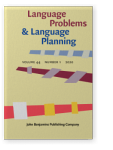Vol. 44:1 (2020) ► pp.66–86
The orthography of revived Cornish as an attempt at pluricentricity
After over twenty years of debate over Cornish orthographies, recognition by the UK government according to the European Charter for Regional or Minority Languages in 2003 led to the creation of what was initially intended as a “single written form” for use in official contexts. However, the inevitable impossibility of finding a compromise that pleased opposing groups of speakers with differing ideologies meant that the eventual Standard Written Form (SWF) was pluricentric, comprising two “main forms”. While these were initially stated to be of equal status, this has been hard to maintain since the SWF’s implementation: with more speakers using Middle Cornish forms, the Late Cornish forms are less visible and commonly believed to be subsidiary. Drawing on such perceptions, along with learning materials and other resources, this paper examines the status of the SWF today and offers some reflections on this unsuccessful attempt at pluricentricity in a minoritised language.
Article outline
- Introduction
- Pluricentricity and polynomy
- Cornish and the SWF
- The creation of the SWF
- Cornish orthographies in the twentieth century
- Context for the development of the SWF
- The outcome of the SWF process
- The use of revived Late Cornish
- The SWF today
- Official uses of the SWF: Visibility in the public space
- Resources for users and learners
- cornishdictionary.org.uk
- Perceptions among speakers
- Conclusions
- Notes
-
References
